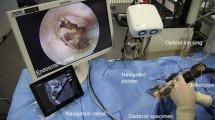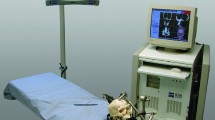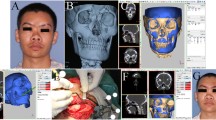Abstract
Various navigation systems with non-invasive patient referenciation and registration methods have been developed in times of minimal-invasive and computer-aided surgery. However, hard data proving the equivalence of different referenciation systems are missing. The present study investigated invasive and non-invasive referenciation systems with regard to overall navigation accuracy as well as navigation accuracy at specific anatomic locations. Four skull models were individually fabricated with a 3D printer based on patient’s CT data sets and fitted with an individual customized silicone skin. 26 titanium screws on defined anatomic locations served as target fiducials. Two non-invasive referenciation systems (headband and headset) were compared with the invasive skull fixed reference array. Registration was done with laser surface scan. The mean accuracy was calculated and the target registration error for eight anatomical locations was measured. Mean accuracy was 1.3 ± 0.12 mm for the skull fixed reference array, 1.44 ± 0.24 mm for the headset and 1.46 ± 0.15 mm for the headband referenciation (non-significant). Navigation accuracy of the invasive referenciation system was significantly superior to the accuracy of both non-invasive systems on the ethmoid sinus with respect to the selected anatomic locations. In the midface headband referenciation was statistically significantly worse than the invasive system. Invasive and non-invasive referenciation systems seem to be on par in terms of overall navigation accuracy, but not regarding specific anatomic locations. Therefore, invasive referenciation systems should be preferred in high precision surgery.



Similar content being viewed by others
References
Wise SK, DelGaudio JM (2005) Computer-aided surgery of the paranasal sinuses and skull base. Expert Rev Med Devices 2(4):395–408
Caversaccio M, Nolte LP, Hausler R (2002) Present state and future perspectives of computer aided surgery in the field of ENT and skull base. Acta Otorhinolaryngol Belg 56(1):51–59
Schlaier J, Warnat J, Brawanski A (2002) Registration accuracy and practicability of laser-directed surface matching. Comput Aided Surg 7(5):284–290
Raabe A, Krishnan R, Wolff R, Hermann E, Zimmermann M, Seifert V (2002) Laser surface scanning for patient registration in intracranial image-guided surgery. Neurosurgery 50(4):797–801 (discussion 802–793)
Citardi MJ, Batra PS (2007) Intraoperative surgical navigation for endoscopic sinus surgery: rationale and indications. Curr Opin Otolaryngol Head Neck Surg 15(1):23–27
Eggers G, Muhling J (2007) Template-based registration for image-guided skull base surgery. Otolaryngol Head Neck Surg 136(6):907–913
Labadie RF, Shah RJ, Harris SS, Cetinkaya E, Haynes DS, Fenlon MR, Juszczyk AS, Galloway RL, Fitzpatrick JM (2005) In vitro assessment of image-guided otologic surgery: submillimeter accuracy within the region of the temporal bone. Otolaryngol Head Neck Surg 132(3):435–442
Ledderose GJ, Stelter K, Leunig A, Hagedorn H (2007) Surface laser registration in ENT-surgery: accuracy in the paranasal sinuses—a cadaveric study. Rhinology 45(4):281–285
Metzger MC, Rafii A, Holhweg-Majert B, Pham AM, Strong B (2007) Comparison of 4 registration strategies for computer-aided maxillofacial surgery. Otolaryngol Head Neck Surg 137(1):93–99
Schicho K, Figl M, Seemann R, Donat M, Pretterklieber ML, Birkfellner W, Reichwein A, Wanschitz F, Kainberger F, Bergmann H, Wagner A, Ewers R (2007) Comparison of laser surface scanning and fiducial marker-based registration in frameless stereotaxy. Technical note. J Neurosurg 106(4):704–709
Cartellieri M, Vorbeck F (2000) Endoscopic sinus surgery using intraoperative computed tomography imaging for updating a three-dimensional navigation system. Laryngoscope 110(2 Pt 1):292–296
Greenfield JP, Howard BM, Huang C, Boockvar JA (2008) Endoscopic endonasal transsphenoidal surgery using a skull reference array and laser surface scanning. Minim Invasive Neurosurg 51(4):244–246
Ecke U, Maurer J, Boor S, Khan M, Mann WJ (2003) Common errors of intraoperative navigation in lateral skull base surgery. HNO 51(5):386–393
Widmann G, Stoffner R, Bale R (2009) Errors and error management in image-guided craniomaxillofacial surgery. Oral Surg Oral Med Oral Pathol Oral Radiol Endod 107(5):701–715
Gunkel AR, Thumfart WF, Freysinger W (2000) Computer-aided 3D-navigation systems. Survey and location determination. HNO 48(2):75–90
Caversaccio, Freysinger (2003) Computer assistance for intraoperative navigation in ENT surgery. Minim Invasive Ther Allied Technol 12(1):36–51
Grauvogel TD, Soteriou E, Metzger MC, Berlis A, Maier W (2010) Influence of different registration modalities on navigation accuracy in ear, nose, and throat surgery depending on the surgical field. Laryngoscope 120(5):881–888
Knott PD, Batra PS, Butler RS, Citardi MJ (2006) Contour and paired-point registration in a model for image-guided surgery. Laryngoscope 116(10):1877–1881
Mascott CR, Sol JC, Bousquet P, Lagarrigue J, Lazorthes Y, Lauwers-Cances V (2006) Quantification of true in vivo (application) accuracy in cranial image-guided surgery: influence of mode of patient registration. Neurosurgery 59(1 Suppl 1):ONS146–156 (discussion ONS146–156)
Grevers G, Leunig A, Klemens A, Hagedorn H (2002) CAS of the paranasal sinuses—technology and clinical experience with the Vector-Vision-Compact-System in 102 patients. Laryngorhinootologie 81(7):476–483
Luebbers HT, Messmer P, Obwegeser JA, Zwahlen RA, Kikinis R, Graetz KW, Matthews F (2008) Comparison of different registration methods for surgical navigation in cranio-maxillofacial surgery. J Craniomaxillofac Surg 36(2):109–116
Troitzsch D, Hoffmann J, Dammann F, Bartz D, Reinert S (2003) Registration using three-dimensional laser surface scanning for navigation in oral and craniomaxillofacial surgery. Zentralbl Chir 128(7):551–556
Marmulla R, Eggers G, Muhling J (2005) Laser surface registration for lateral skull base surgery. Minim Invasive Neurosurg 48(3):181–185
Javer AR, Kuhn FA, Smith D (2000) Stereotactic computer-assisted navigational sinus surgery: accuracy of an electromagnetic tracking system with the tissue debrider and when utilizing different headsets for the same patient. Am J Rhinol 14(6):361–365
Ecke U, Luebben B, Maurer J, Boor S, Mann WJ (2003) Comparison of different computer-aided surgery systems in skull base surgery. Skull Base 13(1):43–50
Balachandran R, Fitzpatrick JM, Labadie RF (2008) Accuracy of image-guided surgical systems at the lateral skull base as clinically assessed using bone-anchored hearing aid posts as surgical targets. Otol Neurotol 29(8):1050–1055
Acknowledgments
The authors thank Professor Dr. J. Schulte-Moenting from the Institute of Biostatistics and Medical Informatics, University of Freiburg, Germany for his support in statistical analysis and Ms I. Neu, make-up artist at the theatre of Freiburg, Germany for fabricating the silicone masks. This work was supported by the Faculty of Medicine, Albert-Ludwigs-University of Freiburg, Germany.
Conflict of interest
The authors declare that they have no conflict of interest.
Author information
Authors and Affiliations
Corresponding author
Rights and permissions
About this article
Cite this article
Grauvogel, T.D., Grauvogel, J., Arndt, S. et al. Is there an equivalence of non-invasive to invasive referenciation in computer-aided surgery?. Eur Arch Otorhinolaryngol 269, 2285–2290 (2012). https://doi.org/10.1007/s00405-012-2023-6
Received:
Accepted:
Published:
Issue Date:
DOI: https://doi.org/10.1007/s00405-012-2023-6




